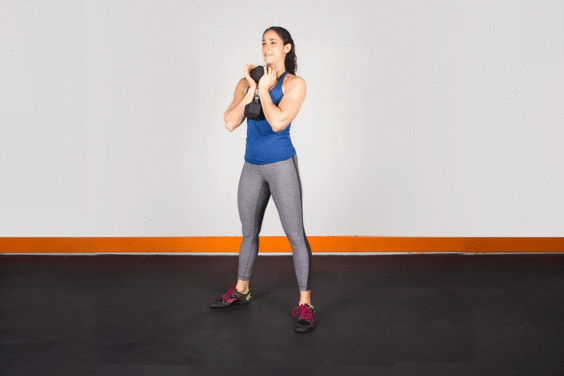Squats are a full-body fitness staple that work the hips, glutes, quads, and hamstrings, and sneakily strengthen the core. Squats may help improve balance and coordination, as well as bone density .
How to do the perfect Squat:
The Bodyweight Squat
1. Stand with feet a little wider than shoulder-width apart, hips stacked over knees, and knees over ankles.
2. Roll the shoulders back and down away from the ears. Note: Allowing the back to round (like a turtle’s shell) will cause unnecessary stress on the lower back. It’s important to maintain a neutral spine throughout the movement.
3. Extend arms out straight so they are parallel with the ground, palms facing down. Or, if it’s more comfortable, pull elbows close to the body, palms facing each other and thumbs pointing up.
4. Initiate the movement by inhaling and unlocking the hips, slightly bringing them back. Keep sending hips backward as the knees begin to bend.
5. While the butt starts to stick out, make sure the chest and shoulders stay upright, and the back stays straight. Keep the head facing forward with eyes straight ahead for a neutral spine.
6. The best squats are the deepest ones your mobility allows. Optimal squat depth would be your hips sinking below the knees (again, if you have the flexibility to do so comfortably). Pro tip: Squatting onto a box until the butt gently taps it will be a reminder to squat low.
7. Engage core and, with bodyweight in the heels, explode back up to standing, driving through heels. Imagine the feet are spreading the floor (left foot to the left, right foot to the right) without actually moving the feet.
Squat Snafus (and How to Fix Them)
Mistake No. 1: Not dropping down low enough
The fix: Take a slightly wider stance, which allows the body to stay steady while it squats deeper, and engages more muscle groups. It’s easy to want to squat just low enough so the thighs are parallel with the ground, but squats can be much more effective when we drop as low as possible (the hip joint lower than the knee joint) while still maintaining good form, Greatist Expert and trainer Dan Trink says.
Mistake No. 2: The knees drift inward
The fix: Turn the toes out (between 5 and 20 degrees, to be technical) to keep knees from caving inward. Knees should track in line with both the ankles and the hips to help avoid injury and get deep in the squat.
Mistake No. 3: The body leans too far forward
The fix: Put most of your weight in the heels when lowering into a squat. The weight distribution will help keep the torso upright throughout the entire movement rather than causing you to teeter forward. It will also help keep the hips back and down, outside of the heels. Think of spreading the floor apart by driving outward through the back/outer portion of the heel.
Mistake No. 4: Descending too quickly
The fix: When weight is added, moving too quickly could increase chances of injury. It’s okay to explode with power when returning to a standing position (so long as the body remains controlled), but sitting into the squat should be a little slower to maintain proper form.
Mistake No. 5: Not warming up
The fix: Warming up is important before taking on such a complex move. It’ll help prepare the body’s joints and muscles for movement, and might even help prevent injury once heavy lifting gets underway. Jumping rope, rowing, and doing bodyweight squats help prep the body for movement. If squatting with a loaded bar, start with an empty bar and add weight slowly.
Thanks to Erica Giovinazzo for demonstrating the movements.
Thanks to Greatist, posted as is.

